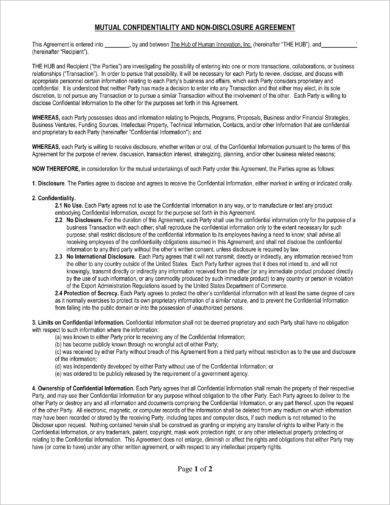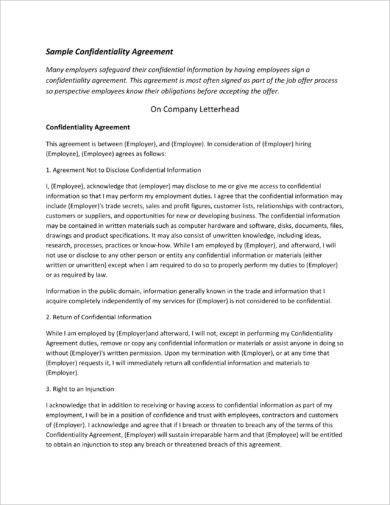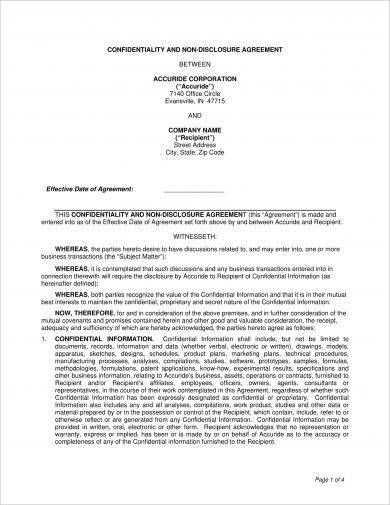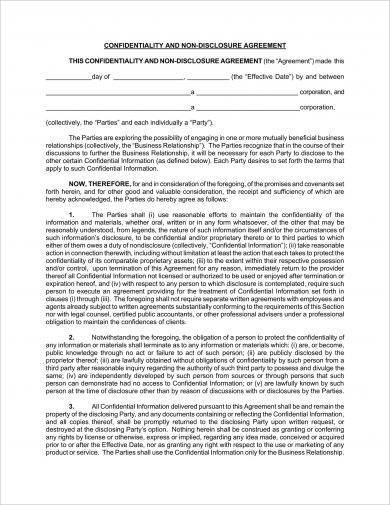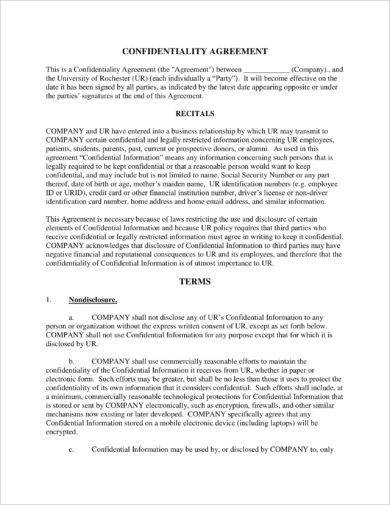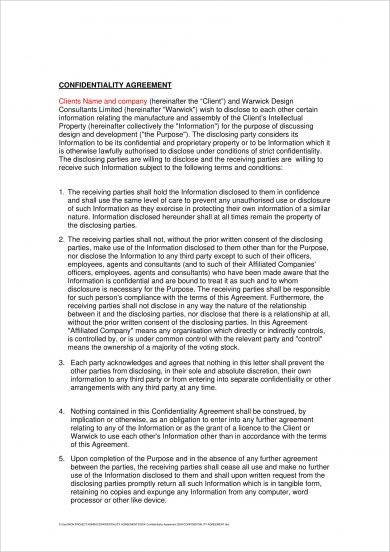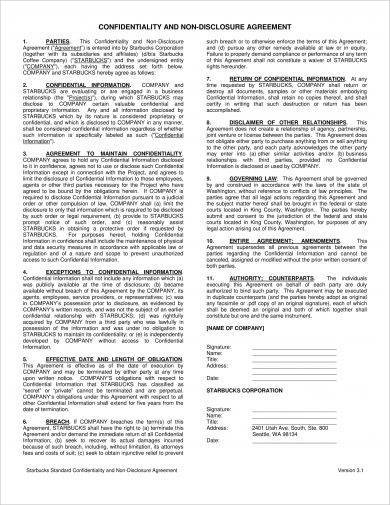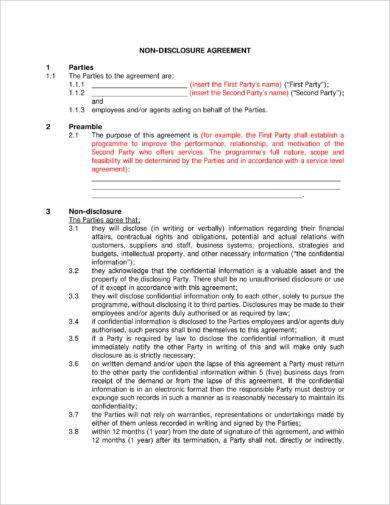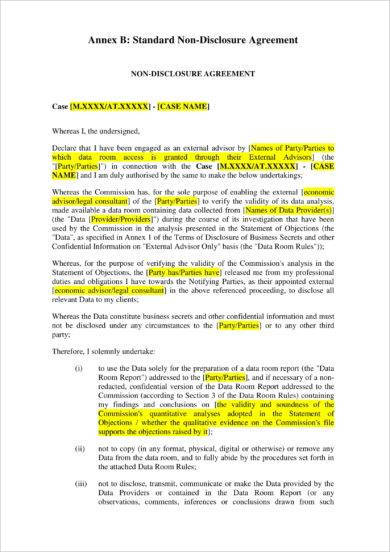13+ Business Confidentiality Agreement Examples
Proprietary information of a company and other classified information must be kept confidential by the parties involved in the agreement. To ensure that the parties would respect their promises of keeping such confidential information, they must sign an agreement formalizing their agreement which is valid and binding and can be used in the court as a legal document.
In this article, provided are the examples of business confidentiality agreement that are presented in the next section.
Business Confidentiality Agreement Template
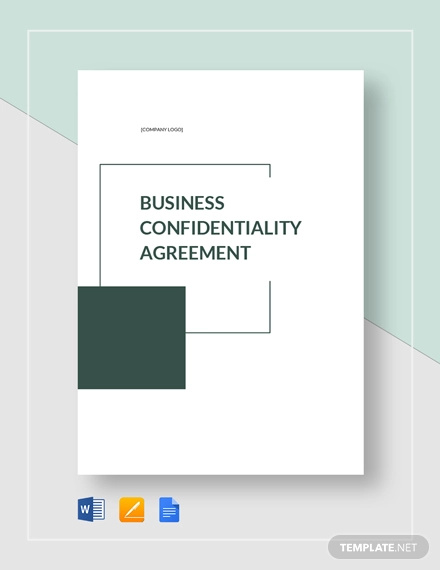
Business Meeting Confidentiality Agreement Example
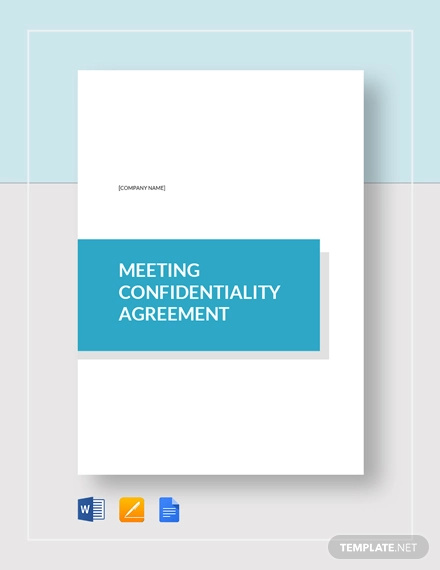
Restaurant Confidentiality Agreement Template

Confidential Disclosure Agreement Template
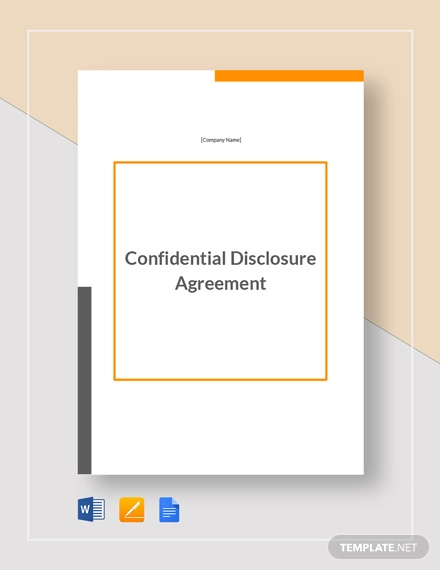
Brief Business Confidentiality Agreement Example
Comprehensive Business Confidentiality Agreement Example
Concise Business Confidentiality Agreement Example
Clauses in a Confidentiality Agreement
In your confidentiality agreement, there are some important information that you must not fail to include such as the following:
1. The Definition of Confidential Information
The first part of the confidentiality agreement must present the information that must not be disclosed by the recipient or the receiving party. The whole point of the agreement is stated in this clause, and this must be understandable enough to prevent any confusion and misunderstanding between the parties involved. The agreement must be specific and concise as to what information must be kept confidential by the recipient.
2. The Parties Involved
This pertains to the parties involved in the general agreement. In this section, it must also disclose and specify who are the related parties that the recipient can disclose the information to, for example, lawyers and accountants. In certain cases, the information that need to be kept confidential may be the work of a graphic designer or editor; hence, they must also be specified in the agreement as among those who are entitled to receive such confidential information.
3. The Term of the Agreement
The term or the length of time or duration of the agreement must be clearly specified. Although many lawyers would agree that the standard confidentiality agreement must be valid forever, many would contest stating that the validity of the information can easily change, especially nowadays where there is a constant change in the discoveries, technologies, and other breakthroughs, thus rendering the previous confidential information obsolete and useless.
4. The Permitted Use of Information
In this section, you must specify the intended use of the information. You may answer the questions, “Why are you sharing this information to the recipient? What is the reason for disclosing such important information to a certain person?” Be specific in your answer. You may also include in this section the third parties who may use your confidential information. However, they are usually presented in another section. You may also see non-disclosure agreement examples.
5. The Legal Obligation to Disclose
There are times where the information that you do not want to be disclosed to another party is required to be disclosed such as disclosing an information to the government or legal authorities. In these cases, the other party is compelled to disclose such information. To protect both parties, it must be included in the simple agreement that instances like these is not a form of violation to the agreement.
6. The Return of the Information
It must also be stated in your agreement in what manner should the confidential information be returned or destroyed. It must contain a clause stipulating how and when this return should occur. Although it may not be possible to completely destroy or return all the information especially with the advent of hard drives and formal email storage, at least all traces of information relating to the classified information must be returned by the recipient party.
7. The Jurisdiction
There are really instances that a conflict may arise between business parties and breaches may occur and misunderstandings may happen. In order to be prepared for the coming of these unfortunate events, you must specify in your commercial agreement which court has jurisdiction over any resulting legal action. It is better to be prepared than bear the loss of a breached contract, and you can avoid this nonsense by affirming jurisdiction in your confidentiality agreement.
8. The Remedies in Case of Breach
In addition to the stipulations with regard to jurisdictions above, you must also include remedies in case of breach of general contract by the recipient or the receiving party. Because the costs of a breach of contract may be hard to prove, mutual agreement must constitute a fair remedy of this breach. It must also include the possible consequences of the breach. Note that the remedy you will be stipulating in your agreement must be fair enough for the recipient party.
9. Responsibility over Legal Fees
In your simple confidentiality agreement, it must also define who will be responsible for the legal fees should a suit be filed. It must clarify which party may be responsible for the fees. To maintain the fairness of the agreement, you may state that each party must be held responsible for their own fees regardless of the outcome of the filed suit. Remember that this must be discussed up front to the recipient to ensure that the disclosing party and the receiving party are on the same page.
10. Non-Binding Clause
Lastly, a non-blinding clause must also be present in your confidentiality agreement. In cases where the basic agreements are initiated prior to negotiations for a merger, temporary project, or consolidation, it must include a non-binding clause, allowing the parties to terminate the relationship at any point. This will signify that the relationship is not permanent, and you should preserve your right to withdraw from the relationship at any point you see fit.
Detailed Business Confidentiality Agreement Example
Formal Business Confidentiality Agreement Example
General Business Confidentiality Agreement Example
Minimalist Business Confidentiality Agreement Example
Ways to Protect Confidential Information
If you want to protect your confidential information, here are the ways that you can use. These ways are also commonly employed by most entities as this can really help in protecting the company’s confidential information.
1. Labeling
You must take sufficient steps to treat your confidential information as confidential by providing labels on the materials, for example, on hard drives and hard copy document. A label may be stated as follows, “Confidential information and property of John Doe Corporation. No part of these materials may be copied, used, or disclosed except with permission of John Doe Corporation.” You may also see non-disclosure confidentiality agreement examples.
2. Non-Disclosure Provision
Employees who have access to confidential information must sign an employment contract stipulating the non-disclosure provisions. Sensitive information must be clearly identified in the agreement. The confidential information must be returned to the disclosing party after the employment. This must be clearly and briefly stated in the formal agreement to avoid misunderstanding.
3. Checking Out Other Agreements for Confidentiality Provisions
When you are the receiving party of other standard agreements, make sure that you check them out before signing an agreement. Most of these agreements may be similar at first glance, but when you carefully read through it, there might be slight revisions such as provisions that are in favor of the disclosing party. Hence, make sure that you carefully read them before affixing your signature.
4. Limiting Access
You must know how to limit the access of the confidential information to only those persons who need to know. In this way, your company’s legal position will be strengthen and this would also help in establishing a practical roadblock. Important hard copy of documents must be kept locked while electronic copies must be protected with passwords. You may also like employee confidentiality agreement examples.
5. Confidentiality Policy
You must also include a confidentiality policy in your employee handbook, and it must specify the procedures for dealing with confidential information. An example for the procedure for dealing with confidential information is shredding the papers instead of directly throwing them in the garbage bin. You may also check out staff confidentiality agreement examples.
6. Doing Exit Interviews
You must conduct interviews for departing employees. During the interview, the employee must be reminded that he or she must return or destroy all the confidential information that he or she is holding in whatever form, hard copy or soft copy. He or she must also be reminded of his or her future obligation with regard to improper use of the confidential information to third parties or his or her future employers. You might be interested in HIPAA confidentiality agreement examples.
7. Notifying New Employees
New employees, upon the start of their employment, must be notified with regard to the information that must be kept confidential. You must not give them an excuse that they are still new to the company and that they are still in the adjusting period. You must see to it that whenever they start their contract of employment, it must also be a start of their responsibility toward dealing with confidential information.
8. Reviewing Agreements from Third Parties
You must also review agreement from third parties. There are cases when the stipulations in the sample agreement is so broad that you cannot easily determine what information you can and cannot disclose. In these cases, it is better to clarify the disclosing party with regard to the information that must be kept classified.
9. Reviewing the Term of the Agreement
Most of the confidentiality agreement contain a time period after which the confidential information is no longer subject to the restrictions in the agreement. You must keep watch of this term for some terms of the agreement may be too short or inappropriate. You and your company must consider checking this matter carefully when you sign a confidentiality agreement. You may also see financial confidentiality agreement examples.
10. Keeping Watch over Visitors
There are times when a visitor is visiting or observing your workplace. Make sure that you keep watch over them and escort them at all times when appropriate. They must be kept away from areas exposed to confidential information and files unless they are authorized or they are among those that need to know such as auditors, accountants, lawyers, and other authorized personnel. You may also like mutual confidentiality agreement examples.
The above are just few of the many ways that you can do to protect the confidential information of your company or the company that you are working for. These will help greatly in keeping the information classified and not be disclosed to parties not related to the company. You may also check out teacher confidentiality agreement examples.
One-Page Business Confidentiality Agreement Example
Professional Business Confidentiality Agreement Example
Standard Business Confidentiality Agreement Example
Wrap Up
A confidentiality agreement is important so that parties would be accountable for their acts when they get into the confidentiality agreement and they will keep their word of keeping the classified information confidential. A confidentiality agreement is a legal document binding the parties involved in the agreement which can be used in court in case of a breach of simple contract.
To make your confidentiality agreement complete and organized, you must carefully arrange the content into clauses, sorting the information that are relevant in the agreement, and combining in one clause those that have similar contents. You may also check out teacher confidentiality agreement examples.
The usual clauses that can be found in a confidentiality agreement are as follows: the definition of confidential information, the parties involved, the term of the agreement, the permitted use of information, the legal obligation to disclose, the return of the information, the jurisdiction, the remedies in case of breach, responsibility over legal fees, and non-binding clause. You may also see basic non-disclosure agreement examples.
In order to keep watch on your confidential information, you must know the ways on how to protect them. These ways are as follows: labeling, non-disclosure provision, checking out other agreements for confidentiality provisions, limiting access, confidentiality policy, doing exit interviews, notifying new employees, reviewing agreements from third parties, reviewing the term of the agreement, keeping watch over visitors. You may also like real estate confidentiality agreement examples.
There are still many other things that you can do in order to fully protect your confidential information, and the above are just some of those that are commonly practiced by most entities.
Lastly, do not forget to check out the examples of business confidentiality agreement presented above.



